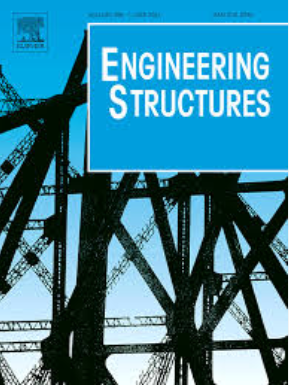Tuned mass damper inerter for mitigating seismic loads on wind turbine hybrid towers
IF 6.4
1区 工程技术
Q1 ENGINEERING, CIVIL
引用次数: 0
Abstract
Steel–concrete hybrid towers (SCHTs) are innovative support structures designed for wind turbines with hub heights exceeding 120 m. Unlike pure steel towers, the hybrid configuration induces a significant base moment during seismic events. Mode superposition analyses have revealed that the higher modes of SCHTs have a greater impact on the base moment than on tip displacement. Controlling multi-modal vibrations in an effective and economical manner is challenging, given that a single conventional tuned mass damper has proven to be insufficient. In this study, a single tuned mass damper inerter (TMDI) was designed to mitigate the multi-modal vibrations of a 160 m SCHT, reduce the total mass of the damper, and improve vibration control performance. The TMDI parameters were optimised to control the vibration modes that have the greatest impact on the base moment of the SCHT based on their sensitivity to frequency responses. Time history analyses were also conducted to verify the expected performance. The results reveal that an optimised TMDI with a mass ratio of μ = 3 % effectively suppresses the base moment induced by the multi-modal responses of the SCHT under seismic excitations.
用于减轻风力涡轮机混合塔地震荷载的调谐质量阻尼器
钢-混凝土混合塔(scht)是为轮毂高度超过120 m的风力涡轮机设计的创新支撑结构。与纯钢塔不同,混合结构在地震事件中会产生显著的基础力矩。模态叠加分析表明,高阶模态对基础弯矩的影响大于对尖端位移的影响。考虑到单一的传统调谐质量阻尼器已被证明是不够的,以有效和经济的方式控制多模态振动是一项挑战。在本研究中,设计了一种单调谐质量阻尼器(TMDI)来减轻160 m SCHT的多模态振动,降低阻尼器的总质量,提高振动控制性能。基于对频率响应的敏感性,优化了TMDI参数,以控制对SCHT基矩影响最大的振动模式。还进行了时间历史分析,以验证预期的性能。结果表明,优化后的质量比为μ = 3 %的TMDI能有效抑制地震作用下结构多模态响应引起的基矩。
本文章由计算机程序翻译,如有差异,请以英文原文为准。
求助全文
约1分钟内获得全文
求助全文
来源期刊

Engineering Structures
工程技术-工程:土木
CiteScore
10.20
自引率
14.50%
发文量
1385
审稿时长
67 days
期刊介绍:
Engineering Structures provides a forum for a broad blend of scientific and technical papers to reflect the evolving needs of the structural engineering and structural mechanics communities. Particularly welcome are contributions dealing with applications of structural engineering and mechanics principles in all areas of technology. The journal aspires to a broad and integrated coverage of the effects of dynamic loadings and of the modelling techniques whereby the structural response to these loadings may be computed.
The scope of Engineering Structures encompasses, but is not restricted to, the following areas: infrastructure engineering; earthquake engineering; structure-fluid-soil interaction; wind engineering; fire engineering; blast engineering; structural reliability/stability; life assessment/integrity; structural health monitoring; multi-hazard engineering; structural dynamics; optimization; expert systems; experimental modelling; performance-based design; multiscale analysis; value engineering.
Topics of interest include: tall buildings; innovative structures; environmentally responsive structures; bridges; stadiums; commercial and public buildings; transmission towers; television and telecommunication masts; foldable structures; cooling towers; plates and shells; suspension structures; protective structures; smart structures; nuclear reactors; dams; pressure vessels; pipelines; tunnels.
Engineering Structures also publishes review articles, short communications and discussions, book reviews, and a diary on international events related to any aspect of structural engineering.
 求助内容:
求助内容: 应助结果提醒方式:
应助结果提醒方式:


